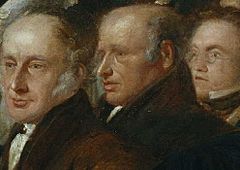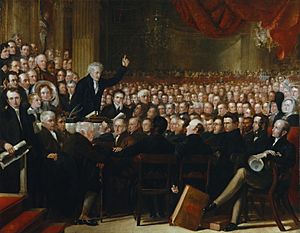George Stacey (abolitionist) facts for kids
Quick facts for kids
George Stacey
|
|
|---|---|

from left:Stacey, William Forster and William Morgan in a detail from an 1840 painting.
|
|
| Born | 1787 |
| Died | 1857 |
| Nationality | British |
| Occupation | Business |
| Known for | Abolitionist |
| Spouse(s) | Deborah Lloyd |
George Stacey (1787–1857) was an important English Quaker and a strong supporter of ending slavery. He worked hard to prevent disagreements within the Quaker community.
Contents
About George Stacey
Stacey was born in Kendal, England. He married Deborah Lloyd, who was also a Quaker. She was related to the famous Lloyd banking family. At that time, Stacey lived in Tottenham. He was a business partner in a company that made chemicals. The company was called Corbyn, Beaumont, Stacey and Messer.
Fighting Against Slavery
In 1823, the Anti-Slavery Society was created. George Stacey became a key member of this group. Many Quakers joined this society. Stacey also worked with fellow Quakers on business projects. One example was the Stockton and Darlington Railway in 1825.
Between 1830 and 1850, Stacey was chosen twelve times. He served as the clerk for the important yearly meeting of the Quakers in London. This shows how respected he was. Stacey had a clear way of speaking. He would explain his views once, but he would not repeat them. He believed repeating them would not convince others. Quakers were very committed to ending slavery. George Stacey was a leading figure in this effort. His business dealt with America and the West Indies. This meant he had direct experience with places where slavery was common.
The 1840 Anti-Slavery Convention
In 1840, a big meeting called the World Anti-Slavery Convention took place. A disagreement happened there. The American delegates had sent women to be representatives. The British organizers were surprised to see female delegates. These women wanted to sit in the main meeting hall.
George Stacey was asked to speak about this issue for the organizers. He said that the women were valued for their work. However, the committee felt that women were not usually included in such meetings. So, the women from America and England were asked to sit in a separate area. A famous painting of the event shows Stacey in the front. Most women are shown in the background, except for Mary Clarkson, the daughter of a main speaker.
Stacey was dealing with a difficult situation. Even though women were asked to sit separately, the 1840 Anti-Slavery Convention helped set the stage. It laid the groundwork for future fights for women's rights. For example, Rachel Stacey took a leading role. She was the secretary of the London Ladies' Negro Friend Society.
Healing Divisions
In 1842-1843, a disagreement happened within the Society of Friends. This was in Salem, Iowa, in America. The Quakers there disagreed on how to deal with slavery. Slavery was still a big part of the American economy. A new meeting house was created, and a separate burial ground.
Four delegates were sent from Britain to help. These were George Stacey, Josiah Forster, his brother William, and John Allen. The group worked to fix the problem. They did not heal the divide right away, but it was resolved by 1848.


